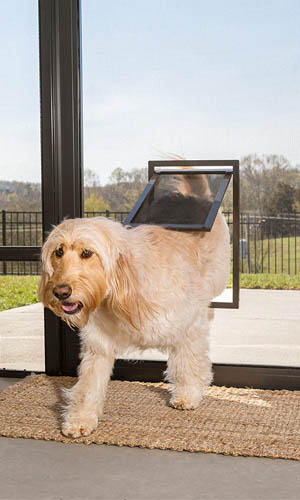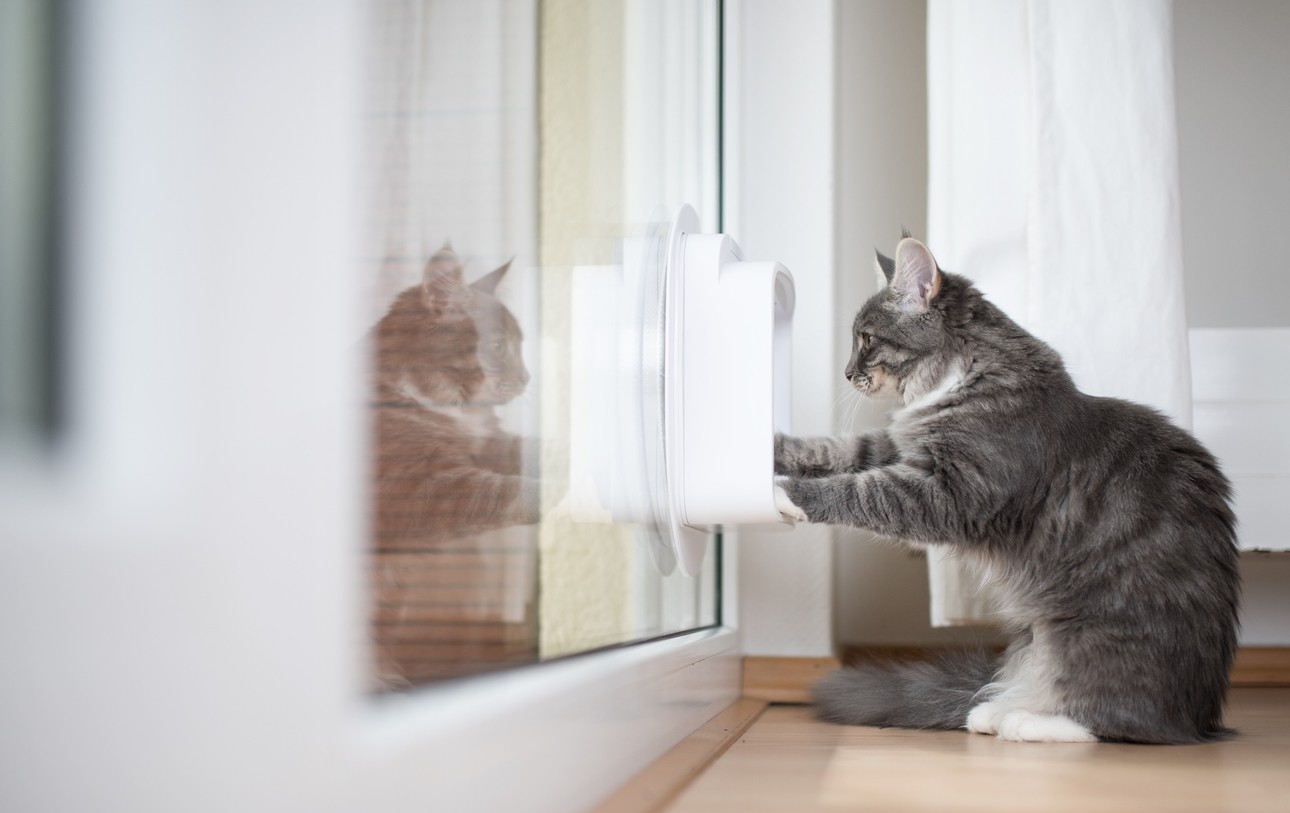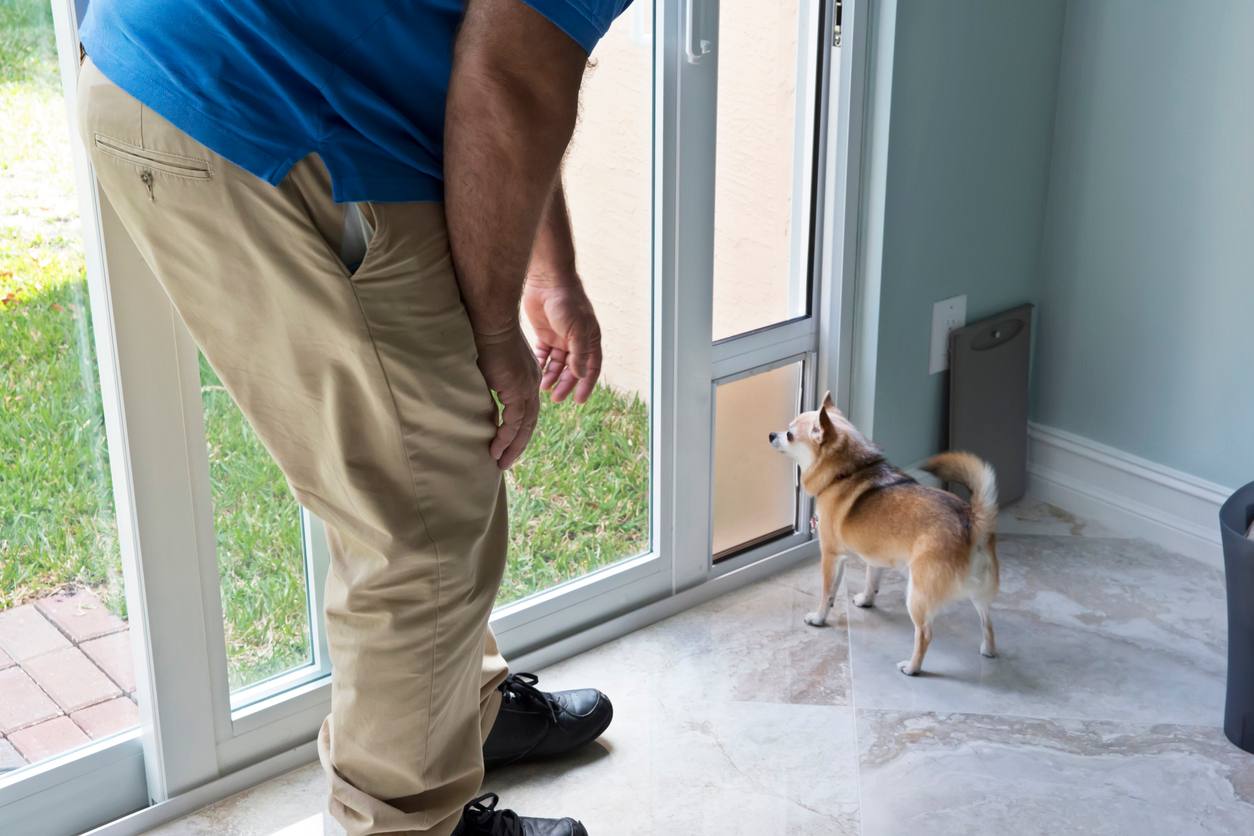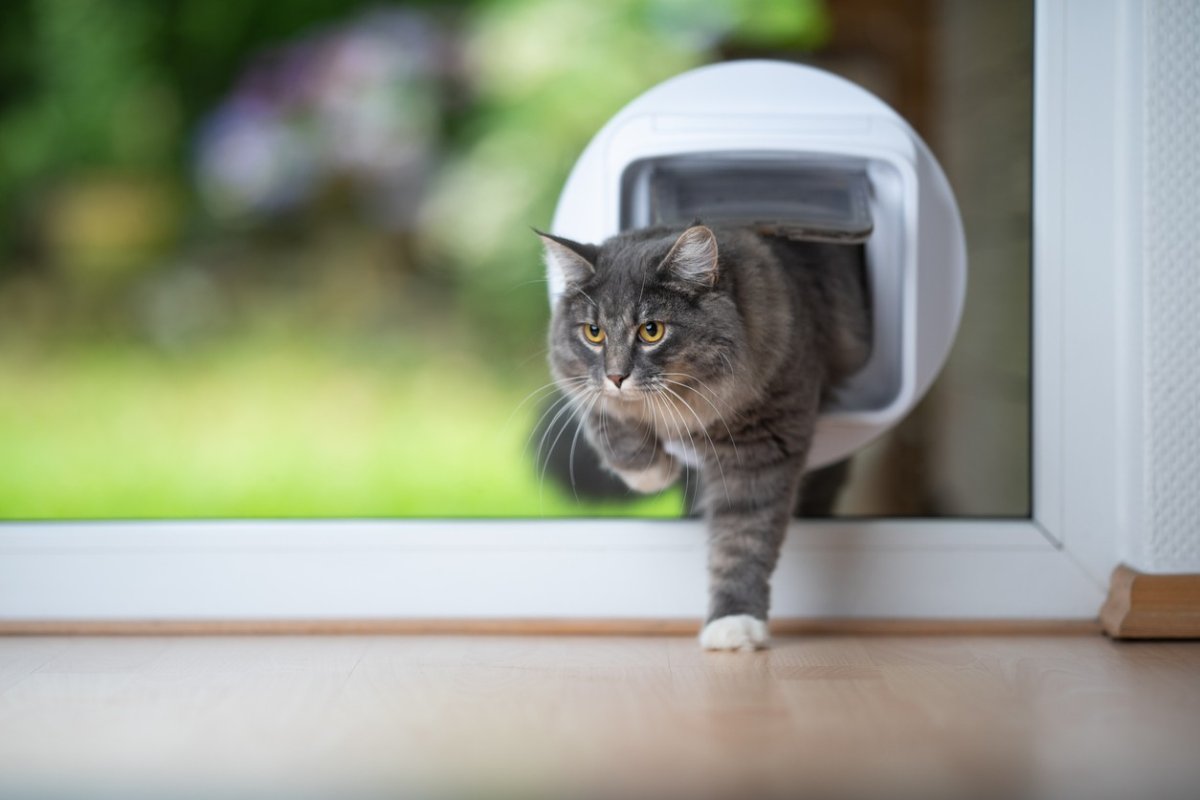We may earn revenue from the products available on this page and participate in affiliate programs. Learn More ›
If you worry about your pet not being able to get outside to potty or exercise while you’re gone, or if you’re just weary of jumping up to open the door every time Fido barks to go out, you may have wondered whether a pet door would be of service. Today’s pet doors come in a variety of sizes—small enough for a cat or large enough for a great dane—but don’t buy one until you know the ins and outs. Keep reading to learn more about this pet-friendly product and to decide whether installing a pet door is right for your home.
RELATED: 10 House Hacks Every Pet Owner Needs to Know
1. Options abound!

If you haven’t shopped for a pet door in a while (or ever), the first thing you’ll notice is that the traditional-style unit with the thin plastic frame and simple flap is far from the only choice. Today’s pet doors run the gamut in design and style. Check out some of today’s top options:
- Energy-efficient pet doors, such as the Ideal Pet Products Ruff-Weather Pet Door (available on Amazon), which features two vinyl door flaps that create a 3-inch air pocket designed to reduce thermal transfer and offer insulating value.
- Pet doors designed to be installed in sliding glass doors, such as the PetSafe Sliding Glass Pet Door (available on Amazon) that fits right into the track of the sliding glass door and can be removed later. This is a great option for renters.
- Pet doors that install in an exterior wall rather than a door, such as the Endura Flap Pet Door (available on Amazon). These doors work well if you want your dog to go in and out to a specific section of your yard, such as a fenced dog yard, but be aware that it can be difficult to match the existing siding if you decide you no longer want the door and want the wall returned to its former look.
- Interior pet doors that lead from one room to another, such as the adorable Kitty Pass Interior Cat Door (available on Amazon) that lets your feline friend slip from room to room as she pleases.
- Inexpensive, lightweight pet doors that install in screen doors, such as the PetSafe Pet Screen Door (available on Amazon) that allows the animal to go in and out when either a standard house door or a sliding glass patio door is open but the screen door is closed. This pet door works best when installed in a screen door that has an aluminum screen, rather than a lightweight nylon screen that might sag under the weight of the door.
- Pet door units that fit into an open window, such as the Ideal Pet Aluminum Sash Window Pet Door (available on Amazon), which requires no installation.
- Security-friendly pet doors, such as the PetSafe Electronic Smart Door (available on Amazon), which will not open unless a pet wearing a microchipped collar approaches the door.

2. Size is essential.
It’s a mistake to browse through images of pet doors, find one with a cat stepping through, and automatically assume that pet door will accommodate your cat. Manufacturers often use the same image on different size pet doors, and if you get one that’s too small, your pet won’t use it and you’ll be out money and the time it took to install it. Measuring your pet before you make a purchase will help you avoid buyer’s regret. Here’s how to do it:
- Research your pet’s breed if it’s still a puppy. A three-month-old German shepherd is less than half the size it will eventually become. Online breed-specific resources, such as this AKC Dalmatian page, will tell you how large your dog will be when fully grown, and it’s a good idea to install the adult size pet door now. Keep adult size in mind for felines, too. Some cats can grow to be very large (like Maine Coons).
- Measure the distance from the floor to the top of your pet’s shoulder blades while it’s standing. Add 2 inches and write the number down.
- Measure the distance from the floor to the top of the elbow of your pet’s front paw while it’s standing. This measurement is the “rise.” Subtract the rise from the first number. The reason you subtract it is because your pet will lift his paw to go in the door. The resulting number is the minimum height you’ll need when buying a pet door.
- Measure your pet’s width at its widest spot. This is usually easiest by standing over your pet with a measuring tape and eyeballing from side to side rather than wrapping the tape around its shoulders or tummy (whichever is widest). When shopping for the pet door, you’ll use these two measurements. Select a door that’s the next-largest in size to your measurements.
If you have more than one pet, use the shoulder measurement and width of the largest one and use the rise of the smallest. In many cases, different size pets can use the same door as long as the height accommodates the largest pet and the smallest pet can lift its leg high enough to get through the door.
Note: If your pets are very different in size—for example a Saint Bernard and a toy poodle—a single pet door is unlikely to accommodate both since a tiny dog (or cat) may not be able to push open the magnetic flap on an extra-large door.
3. Cost depends on door type and whether or not it’s a DIY project.
Pet doors vary widely in price depending on the type, starting under $40 for a basic model that installs in an exterior door, and running as much as $450 or more for a pet door designed to install in an exterior wall. Paying for professional installation can add $75 to $500 to the total price tag.
Pet door panels that fit in sliding glass doors are the simplest of all to install because the panel fits right in the track of the door—no cutting necessary. You’ll need a drill and a screwdriver, but installing one of these pet door panels is usually a fairly simple DIY project. If you choose to have it professionally installed, it’s unlikely you’ll pay more than $75.
If you know your way around a measuring tape, drill, and jigsaw, installing a pet door in an exterior wood door is a very doable DIY project. Pet doors typically come with paper templates and complete instructions on how to position the door and install it.
Installing a pet door in a steel or metal door, however, is a more complex chore, because a saw blade can catch on the metal surface of the door and bend or warp it. In this case, some homeowners may feel more comfortable having a pro install the pet door, which could run $75 to around $125. If you decide to attempt installing it on your own, you may need to use aviation tin snips to cut the metal and then use a saw to cut the core of the door.
If you’re looking to install a permanent pet door in the exterior wall of your home, this is a job for a pro, who will know how to cut through a wall without damaging any pipes or wiring within. Labor for this type of installation is the priciest, costing an average of $300 to $500.

4. Your pet may need encouragement.
Dogs and cats that are not used to going in and out of pet doors may be leery at first to use one. If your pet shies away from the door, try the following tips.
- Recruit a friend or family member to stand on the opposite side of the door and call your pet while you open the flap with your hand so your pet sees it’s possible to step through. It may work even better if your helper is luring your pet with a tasty treat.
- If your pet is small enough, have your helper hold the door flap open while you physically lift your pet through the opening. This works well with cats and small dogs.
- Encourage, don’t demand! Be patient. If your pet is frightened of the door, stop the training and try again another time. New things can be stressful for some pets, but if you back off, your pet will probably examine the door in its own time and be more receptive to trying again later.
5. Pet doors aren’t for everyone.
While pet doors offer Fluffy and Fido a bit of freedom and can make life easier on you by allowing them to go in and out without your help, pet doors do have some notable downsides you’ll want to consider before buying:
- Installing a pet door in an exterior door will void the home door’s warranty.
- Large pet doors can pose security problems, creating a weak point in your home’s exterior where an intruder might be able to gain entry.
- Small children can crawl out through medium to large size pet doors.
- Cats often enjoy bringing their “catch” back inside the home, leaving you with the remains of a bird or a mouse to clean up.
- Unwanted animals, such as neighborhood dogs, raccoons, possums, or even skunks might inadvertently make their way into your home.
- Pets can track mud into the home before you can stop them.
If you still think a pet door will be a good fit for your home, go for it. Many pet owners have installed pet doors without any regrets, happy to give their pets a little more freedom.


